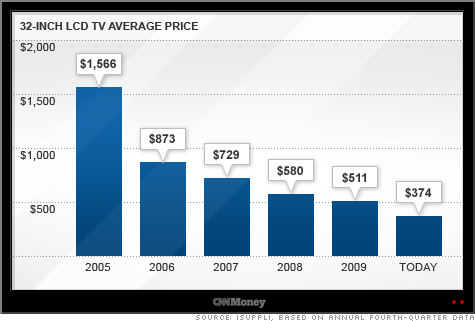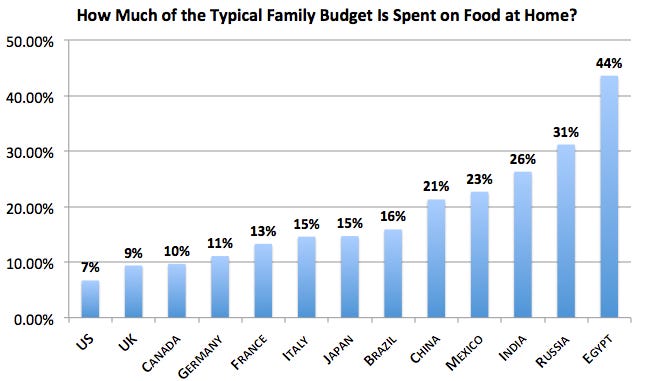Can People Afford Negative Foods?
The Affordability Myth (27th) Edition of the Negative Foods Newsletter
Rock star entertainment lawyer Rachel Miller emailed recently: “I think you should address the fact that most of the population is never going to buy beef from the good actors because it’s not affordable…. I can’t imagine some fancy folks buying good beef is enough to move the needle significantly.”
It is a great question, so let’s address it.
First, let’s concede that regeneratively produced beef is currently priced higher than industrial beef. And then let’s start with what we all know intuitively, which is that new ways of creating better products are often more expensive. You already know the flat screen television example.
And then there’s Tesla, which started with the >$100K roadster, then released the <$100K Model S, and now offers the ~$40K Model 3. Tesla is now selling more vehicles in the US than Lexus, Volkswagen, Mercedes or BMW. This scale reduces their unit costs and has enabled Tesla to continue to sell cars at lower and lower prices.
And this isn’t just a story for rich people who can afford pricey cars. Electric cars are already, or soon will be, cheaper to buy and own than gasoline cars.
Car & Driver magazine in 2010 missed the rise of EVs:
Today, Fast Company says “by 2023, the cost is likely to fall far enough that car companies can make and sell mass-market electric vehicles (EVs) at the same cost as cars running on fossil fuels.“ Bloomberg more conservatively says “Unsubsidized price parity between EVs and internal combustion vehicles is achieved in most segments and countries by the late 2020s, and some reach this point much sooner”.
Can we expect a similar trend with Negative Foods? Yes.
But analogies only go so far. Below are my arguments.
Economies of Scale. Costs go down as nascent industries achieve scale. When Nestle & Walmart expand their offerings of foods with regenerative footprints, and when the USDA supports the transitions, and when legions of venture-backed entrepreneurs eat Big Foods’ lunch by capturing market share with Negative Foods startups, then we’ll achieve the scale that will bring down costs to the point that mainstream America can afford Negative Foods.
This is the main argument. When regenerative agriculture scales, the costs will come down and everyone will be able to afford it.
But there are plenty of other reasons to believe that the transition is achievable.
1. Regenerative Agriculture Can Be More Profitable. Numerous studies (here and here and here) suggest that farmers using regenerative practices can achieve higher profits by reducing their input costs. If farms can indeed reduce their costs, we will be less exposed to upward pressure on consumer pricing from regenerative supply chains.
2. We Should Eat Less Beef. When it comes to beef, converting to regenerative practice may indeed result in less beef (as more land will be required for the same volumes). Price elasticity (with food at least) is real, and if there is less beef in the marketplace, this may drive up prices. And that’s fine. U.S. meat consumption has increased 40% since 1961, which exceeds U.S. dietary guidelines. Reducing our beef consumption would prudently save resources and the associated emissions, and Americans would be happier and healthier.
3. We Spend Too Little on Food. Compared to other countries, we spend very little of our income on food.
And we spend less of our income on food than did our grandparents.
If Americans can’t afford to buy food that costs a bit more, we don’t have a food price problem, we have a poverty problem. And as I point out below, cheap food - at least the way we do it - isn’t the correct response to the poverty problem. And it isn’t really cheaper.
4. Our Food is More Expensive Than its Price. The Scientific Group of the United Nations Food Systems Summit 2021: “One of the central problems of current food systems is that many of the costs of harmful foods are externalized, i.e. are not reflected in market prices.” This report concludes that food is roughly a third cheaper than it would be if externalities (which include substantial environmental, social and health costs) were included in market pricing. We are paying for those externalities, we just aren’t paying for them in the retail pricing.
5. We Pay More for our Food in Healthcare Costs. In the United States, the link between our health and our food is quite clear, as we pay for our artificially cheap food with unnecessarily high healthcare costs. Dariush Mozaffarian, the dean of the Tufts Friedman School of Nutrition Science and Policy, writes in the New York Times:
6. Waste Not, Want Not. A huge portion of the food we produce in the U.S. does not get consumed, pouring costs and resources down the drain. When we reduce food waste, we will push down overall food costs. In addition, reducing the amount of crops grown to feed cattle (and make ethanol) could also push down the costs of food. There is quite a bit of waste in this system that can be squeezed out to reduce consumer costs.
7. The Costs of Climate Change are Even More Expensive. The first argument was that economies of scale will make Negative Foods affordable. The last argument is that we can’t afford to stay the course. The alternative to transitioning to Negative Foods, as part of a comprehensive plan to reverse climate change, will be far more costly than the potentially higher prices of Negative Foods. A report from insurer Swiss Re states it plainly: “By mid-century, the world stands to lose around 10% of total economic value from climate change.” We can’t afford not to transform our food system.
The Case for Being Bullish. Converting our food system so that it is a lever to reverse climate change will not make food unaffordable for poor people. At scale, regeneratively produced food may even be less expensive. But that’s not the whole story. Even if the conversion did result in higher prices, as a society we would be able (or should be able) to afford higher priced food. And we’d be better off enjoying the benefits of a food system that didn’t make us unhealthy and damage the economy.
For Your Consideration:
In Sonoma County, ‘Regenerative Agriculture’ Is the Next Big Thing
Plant-Based Food Companies Face Critics: Environmental Advocates
It has long been known that grass fed beef is more nutritious
LandFund Partners Launches Open-End Soil Enrichment Fund
Beef Is a Problem. This Seattle Steakhouse Wants to Be Part of the Solution
In conversation with Jane Goodall on climate change — and remaining hopeful for the future
Spanish Chef Introduces a Seagrass Grain to Help Solve Climate Crisis
CIBO Technologies raises $30m Series C funding for carbon trading tools
Here's what Whole Foods Market says will trend in 2022
Food Waste Market Map: Invest in food waste solutions to fight hunger & climate change
New Barn Organics Introduces Nationally-distributed, ROC Eggs
I tried to prove that small family farms are the future. I couldn’t do it








